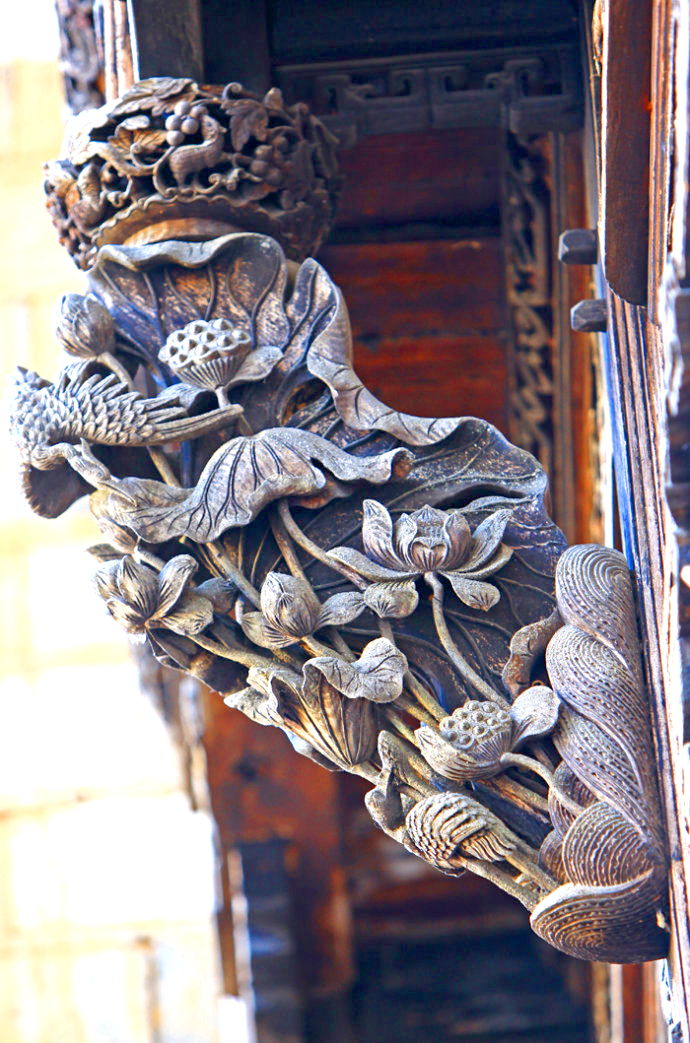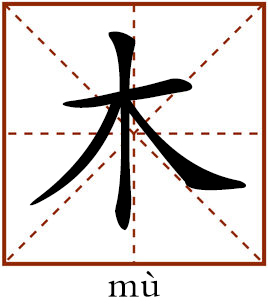Huizhou woodcarving

A woodcarving of a local residence at Wuyuan County in ancient Huizhou area portrays the he (cranes) and he (lotus), both of which are homophones of he (harmony).

Mu (trees or wood) in Chinese language refers to all kinds of trees. Sharing the same component “木,” scores of Chinese characters mean either various kinds of trees, such as 松 (pine trees), 桦 (birches) and 枫 (maple trees), or wooded items such as 杖 (walking sticks) and 栏 (railings).
The ancient Huizhou area around the Yellow Mountain lies on the borders of Anhui, Zhejiang and Jiangxi provinces. This area has given birth to various arts including the Huizhou style of woodcarving.
Huizhou was famous for its inkstick manufacturing industry as early as the late Tang Dynasty. Inksticks were usually printed with intricate pictures, which was far more difficult considering the soft texture of the material. The wooden molds used to print these pictures were carved with diaglyphs, a type of sunken engravings.
Huizhou woodcut printing reached its apex in the Wanli Period (1573-1620)as Hui merchants emerged as important players in the economy. The development of woodcut printing promoted the Huizhou style of woodcarving.
The increasing fortunes of Hui merchants prompted the construction of lavish residences. Woodcarvings became popular ornaments for these structures, and developed into a tradition in the Huizhou area.
The type of Huizhou woodcarving was relatively plain and simple thematically in the Ming Dynasty. More themes emerged during the Qing Dynasty, integrating folklore and opera stories with rich detail. Some of these works were carved with mountains, rivers, flowers and birds, representing the elegant tastes of the scholar-official culture. Others also showed historical scenes, or stories in literature, which demonstrated the aesthetic tastes of these wealthy merchants.
The Huizhou woodcarving was best expressed in ancient architecture, especially on the baffle boards in the tianjing courtyards. Tianjing literally means heaven-well, a style of building in South China with a height larger than its diameter or breadth. This height is what gave it its name, as viewers standing at the center of the courtyard felt they were looking up at heaven from the bottom of a well. In addition, the windows on both sides of the main hall were also an arena for woodcarving artists to demonstrate their techniques and the house owners to show off their fortunes.
Painters in the Huizhou area in the Ming and Qing dynasties helped the merchants design the pictures carved on these works. The woodcarving showed distinct local characteristics. For example, the beautiful scenes of the Yellow Mountain were showcased on the woodcarving works. The frequently carved pine trees, rocks, clouds, mountain springs and unique plants were typical views of the Huizhou area.
Huizhou woodcarving also covers historical, literary, folklore stories and social life. Common figure carvings include the stories of Twin Genii He-He. He-He refers to legendary gods of harmonious union with one holding a he, meaning a lotus, and the other holding a he, meaning a box. Both these words are homophones of he, or “harmony,” representing the desire for harmony within the family.
Other stories demonstrating Confucian values, such as loyalty, filial piety, forbearance and justice, were also common, including the 24 stories of filial piety, a hundred behaviors of forbearance as well as stories of patriotic generals. In addition, daily scenes of fishing, gathering firewood, farming and reading books were also common themes.
Of all the themes in woodcarving in Huizhou area, filial piety was the most important as well as one of the core values of Confucian ethics. The filial piety of the artists and the home-owners can also be seen in these woodcarvings.
Yi, meaning righteousness, was another commonly admired theme. It was part of the perfect spiritual state that Chinese people pursue. The woodcarvings advocated the principle that one should maintain integrity when tempted by money or all kinds of benefits. The idea shown in Huizhou woodcarving represented the belief that the virtuous spiritual nature of humanity outweighs material benefits, and this theme was at the core of traditional Chinese culture.
Kuai Zhenghua is from the Kuai Zhenghua Woodvarving Studio.
(edited by CHEN ALONG)
